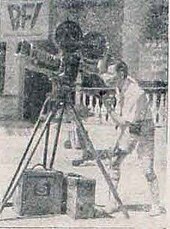Si Pitoeng (film)
| Si Pitoeng | |
|---|---|
| Directed by | Wong brothers |
| Produced by | Wong brothers |
| Starring |
|
Production company | Halimoen Film |
Release date |
|
| Country | Dutch East Indies |
Si Pitoeng is a film from the Dutch East Indies (modern-day Indonesia) that was released in 1931. Directed by the Wong brothers and starring Herman Shim and Ining Resmini, it was the first film based on the life of Si Pitung, a bandit from Batavia (modern-day Jakarta).
Background
[edit]The historical Si Pitung was a 19th-century bandit in Batavia, Dutch East Indies (modern-day Jakarta, Indonesia). He began his criminal career in 1892 by robbing Hadji Sapiudin, a wealthy landowner who lived northeast of Batavia.[1] He then continued stealing, although some tellings have him only stealing from people who collaborated with the Dutch colonial government.[2] He was eventually caught in an ambush and killed by the police officer A.W.V. Hinne and several assistants.[3] Later folklore led to him becoming an Indonesian Robin Hood, stealing from the rich to give to the poor,[4] and attributed mystical powers.[5]
Plot
[edit]Pitoeng (Herman Shim) is a Muslim bandit of Betawi descent. He steals from the rich citizens while dealing with a love interest (Ining Resmini) and police officer (Zorro).
Production
[edit]
Si Pitoeng was produced by Halimoen Film.[6] The Indonesian film historian Misbach Yusa Biran suggests that the theme was chosen by the film's financiers.[7] Si Pitoeng was the first film about Pitung.[8] The kroncong singer Ining Resmini, who had previously acted in Rampok Preanger (1929), was cast as Pitoeng's love interest, while the peranakan Chinese actor Herman Shim was cast as Pitoeng.[7] Filming was completed in Bojong Loa, Bandung.[9]
The film was directed by the Wong brothers, who had studied film in the United States. The brothers' influence led to the film, despite being based on an Indonesian bandit, coming across as an American film;[7] some viewers described it as a sort of Western.[10] The brothers had been directing films since Lily van Java (Lily of Java) in 1927 and generally dealt with Chinese-Indonesian themes.[11]
Release and reception
[edit]Si Pitoeng was released by 6 February 1931,[9] although little is known about its box office performance.[10] Another film about the bandit, also entitled Si Pitung, was released in 1970 and was the best performing Indonesian film of the year;[12] this later production had three sequels.[13]
See also
[edit]References
[edit]- Footnotes
- ^ van Till 1996, p. 462.
- ^ Jakarta City Government, Pitung, Si.
- ^ van Till 1996, p. 475.
- ^ van Till 1996, p. 465.
- ^ van Till 1996, p. 463.
- ^ Biran 2009, p. 111.
- ^ a b c Biran 2009, pp. 113–114.
- ^ van Till 1996, p. 461.
- ^ a b Doenia Film 1931, Si Pitoeng.
- ^ a b van Till 1996, p. 467.
- ^ Sun 2006, p. 123.
- ^ van Till 1996, p. 468.
- ^ van Till 1996, p. 469.
- Bibliography
- Biran, Misbach Yusa (2009). Sejarah Film 1900-1950: Bikin Film di Jawa [History of Film 1900-1950: Making Films in Java] (in Indonesian). Komunitas Bamboo working with the Jakarta Art Council. ISBN 978-979-3731-58-2.
- "Film Si Pitoeng Alias Zigomar van Java" [Film "Si Pitoeng", alias Zigomar of Java]. Doenia Film (in Indonesian). Batavia. 15 February 1931. p. 10.
- "Pitung, Si". Encyclopedia of Jakarta (in Indonesian). Jakarta City Government. Archived from the original on 5 January 2013. Retrieved 15 May 2012.
- Sun, Wanning (2006). Media and the Chinese Diaspora. New York: Routledge. ISBN 978-1-134-26359-2.
- van Till, Margreet (1996). "In Search of Si Pitung: The History of an Indonesian Legend". Bijdragen tot de Taal-, Land- en Volkenkunde. 152 (3): 461–482. doi:10.1163/22134379-90003007. ISSN 0006-2294. OCLC 770588866.
External links
[edit]- Si Pitoeng at IMDb
